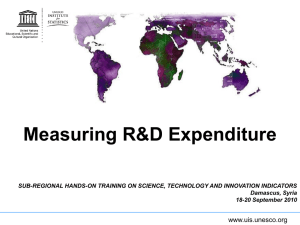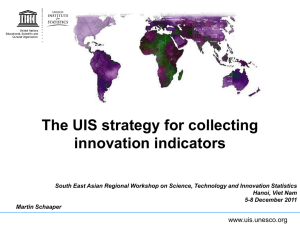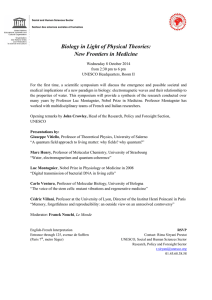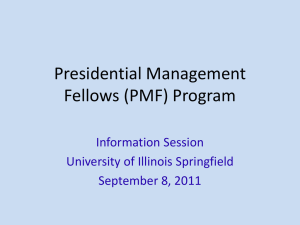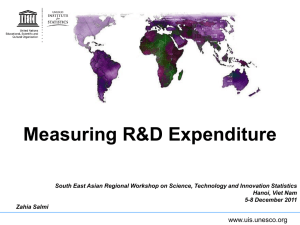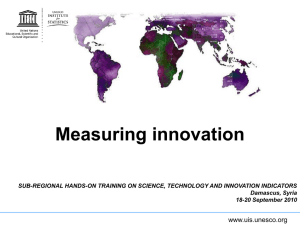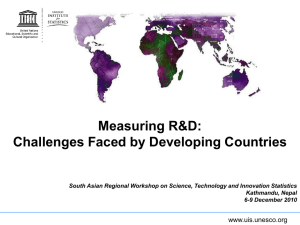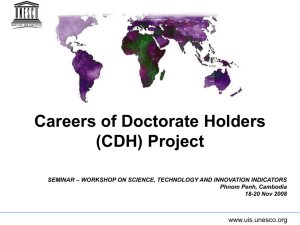Measuring Research and Experimental Development
advertisement
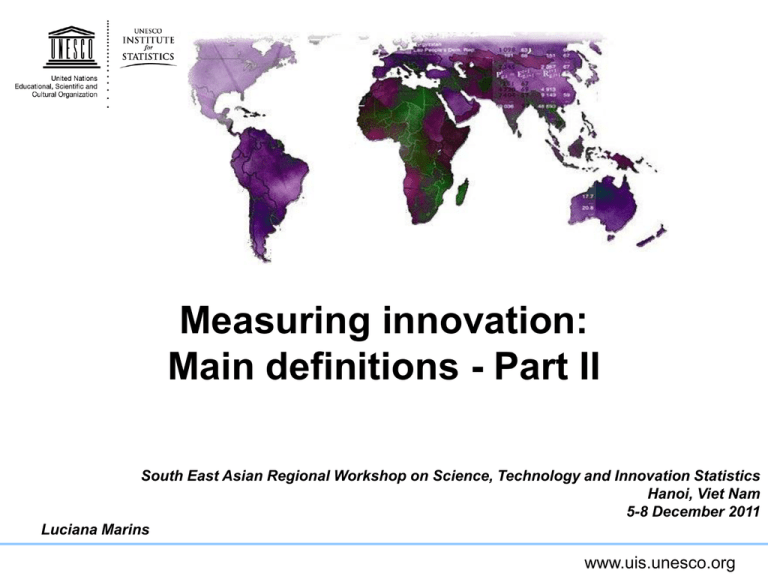
Measuring innovation: Main definitions - Part II South East Asian Regional Workshop on Science, Technology and Innovation Statistics Hanoi, Viet Nam 5-8 December 2011 Luciana Marins www.uis.unesco.org Innovation activities (1) Innovation activities: all scientific, technological, organisational, financial and commercial steps which (intended to) lead to the implementation of innovations; Some innovation activities are themselves innovative, others are not novel but necessary; R&D not directly related to the development of a specific innovation. www.uis.unesco.org Innovation activities (2) For product and process innovations: • Intramural (in-house) R&D; • Acquisition of (extramural) R&D; • Acquisition of other external knowledge; • Acquisition of machinery, equipment and other capital goods; • Other preparations for product and process innovations; • Market preparations for product innovations; • Training. www.uis.unesco.org Innovation activities (3) Preparations for marketing innovations: • Activities related to the development implementation of new marketing methods; and • It includes acquisition of other external knowledge and of machinery, equipment, and other capital goods and training; • Expenditures for using these methods in daily business are NOT included. www.uis.unesco.org Innovation activities (4) Preparations for organisational innovations: • Activities undertaken for the planning implementation of new organisation methods; and • It includes acquisition of other external knowledge and of machinery, equipment, and other capital goods and training. www.uis.unesco.org Kinds of innovation activities Successful - resulted in the implementation of a new innovation (not necessarily commercially successful); Ongoing - work in progress, which has not yet resulted in the implementation of an innovation; Abandoned - before the implementation of an innovation. www.uis.unesco.org Classifying firms by degree of innovativeness Innovative firm: • Implemented an innovation; • Not necessarily a commercial success; Innovation-active firm: • Had innovation activities - ongoing and/or abandoned; • Regardless of implementation; Potentially innovative firm: • Innovation efforts but no achieved results; • Key element for innovation policy; • (Annex). www.uis.unesco.org Factors influencing innovation Objectives: Motives for innovating; Effects: Observed outcomes of innovations (Table 9); • Impacts on firm performance; • Time lag; Hampering factors: • Reasons for not starting innovation activities at all; • Factors that slow innovation activity or have a negative effect on expected results (Table 10). www.uis.unesco.org Linkages Linkages: connections with other agents; Source, cost, level of interaction; Types of external linkages: • Open information sources; • Acquisition of knowledge and technology; • Innovation co-operation. www.uis.unesco.org Sources for transfers of knowledge and technology Open Sources for information purchases of sources knowledge & technology Cooperation partners Internal sources within the enterprise: R&D / Production / Marketing / Distribution Other enterprises within the enterprise group * * * * * * * * * * * * * * * * * * * * * * * * * * * * * * * * External market and commercial sources: Competitors Other enterprises in the industry Clients or customers Consultants / consultancy firms Suppliers Commercial laboratories Public sector sources: Universities and other higher education institutions Government / public research institutes Private non profit research institutes Specialised (semi) public innovation support services General information sources: Patent disclosures / Professional conferences, meetings, literature and journals / Fairs and exhibitions / Professional associations, trade unions / Other local associations / Informal contacts or networks / Standards or standardisation agencies / Public regulations * www.uis.unesco.org Appropriability Ability of enterprises to appropriate gains from innovation activities: • Formal methods: patents, registration of design, trademarks, copyrights, confidentiality agreements, trade secrecy; • Informal methods: secrecy that is not covered by legal agreements, complexity of product design, lead time advantage over competitors. www.uis.unesco.org Developing countries Developing countries 3rd OM standards, adaptations; LA: the Bogota Manual (RICYT, 2001); UIS: Annex to 3rd OM… Innovation Surveys in Developing Countries. www.uis.unesco.org Characteristics of innovation in developing countries Size and structure; Instability; Informality; Particular economic and innovation environments; Reduced innovation decision-making powers; Weak innovation systems; Characteristics of innovation. www.uis.unesco.org Innovation measurement in developing countries Potentially innovative firm; Measurement priorities - why / what / how: • Innovation capabilities (HR, Linkages, ICTs); • Expenditure on innovation activities; • Organisational innovation. www.uis.unesco.org Adaptations ICTs in innovation surveys Linkages • Agents + Types + Location; Innovation Activities • • • • • Hardware purchase and Software purchase (split); Industrial design and Engineering activities (split); Lease or rental of machinery, equipment and other capital goods; In-house software system development; Reverse engineering. Human resources and training Quality and environmental management www.uis.unesco.org Methodological issues for developing country contexts Weakness of statistical systems; Questionnaire design; Survey application; Will be discussed later Frequency; Publication; Difficulties… • Lack of appreciation of the importance of innovation; • Managers are secretive about finance; • Lack of adequate legislative base. www.uis.unesco.org Thank you! http://www.uis.unesco.org l.marins@unesco.org www.uis.unesco.org



